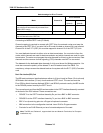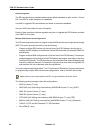
Specifications
Release 3.3 97
Dual Port T1 PRI (Universal T1) Card Features
• 1.544 Mbps primary rate (23B+D) connectivity (2 links)
• B8ZS or AMI line coding
• Super Frame (SF) or Extended Super Frame (EXF) framing
• Generation and detection of the following status indications:
- Loss of Signal (LOS or Yellow Alarm)
- Alarm Indication Signal (AIS or Blue Alarm)
- Loss of Frame Alignment
- Excessive CRC errors
Dual Port E1 PRI (Universal E1) Card Features
• 2.048 Mbps primary rate (30B+D) connectivity (2 links)
• CRC4 enable or disable
• Generation and detection of the following status indications:
- Loss of Signal (LOS or Yellow Alarm)
- Alarm Indication Signal (AIS or Blue Alarm)
- Loss of Frame Alignment
- Excessive CRC errors
Programmable Data Inversion (NA only)
This feature is required for inter-working with T1/D4 and BRI interfaces that have inverted
in-band data enabled on a per-call basis. This feature is programmed on a link-by-link basis
(default means no inversion).
Administration of PRI Card Software
The IMAT (ISDN Maintenance and Administration Tool) software runs on an independent
computer with a Windows 95, 98, or 2000 Professional operating system. The IMAT computer
is used for programming and maintaining the PRI configuration databases. It accesses the PRI
card either through a direct connection on-site, or remotely through a modem.
To install the IMAT application, refer to the PRI software CD-ROM jacket. For more information
on IMAT, see Using the ISDN Maintenance and Administration Tool (IMAT).
Options are managed and controlled as features on the 3300 ICP. The options are configured
simultaneously on all PRI cards installed on the 3300 ICP. This means, for example, that if
Min/Max were enabled, every PRI card in the 3300 ICP would have this feature enabled.
Note: To determine if a Universal T1 is a PRI T1 or DS1/T1 Formatter II, you must check the card
by inspecting the lock latch or using the Firmware command.


















